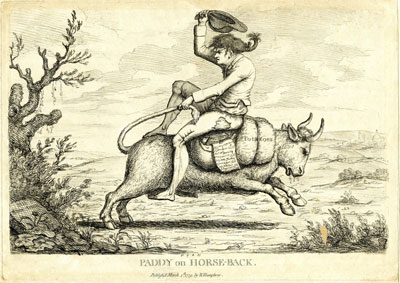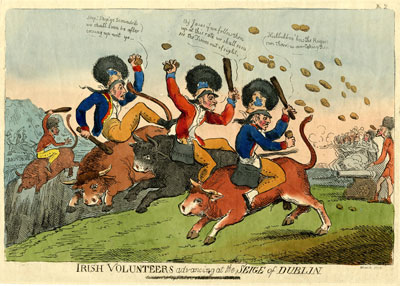Paddy on Horse-Back
This somewhat confusing but visually striking image is generally considered one of Gillray's earliest works. It shows an Irishman (Paddy) recently arrived in England—impoverished, stupid, and disheveled—riding a bull (not a horse) backwards to London. Along with a healthy supply of the staple of the Irish diet (potatoes of course), he carries a book entitled A New System of Fortune Hunting and a list of the names and potential dowries of presumed British prospects. They include Lady Mary Rotten Rump with £30,000, the Honourable Mrs. Crupper-Wag with £10,000, and Lady Betty Crawthing. with £15,000.

© Trustees of the British Museum
Early in his career, Gillray frequently relied on national sterotypes as the basis of his prints. Then as now there was always a market for xenophobia. Examples include Sawney in the Bog-House, which skewered the Scots, and and Politeness. which attacked the French—both in 1779. And it continued with greater sophistication in prints like John Bull Triumphant and Argus which portrayed France, Spain, Holland, America and Scotland using similarly reductive national identifiers.
In this print Gillray seems to be using two different stereotypes of an Irishman, but at cross purposes. One is the image of the Irishman as poor, backward, and unsophisticated, whose only diet is potatoes, who can't tell the front from the back of a steed, or (for that matter) a bull from a horse. This is an image consistent with another print from 1779 described by Padhraic Higgins suggesting that the typical Irish Paddy was so ignorant that he thought that free trade meant trade without cost:
In November [1779] the Hibernian Chronicle reported that "a gentlemen just returned from England assures us, that [in] the print-shops in London. . .he saw affixed to the window the ludicrous figure of a poor Teague [another name for an Irishman] with brogues without soles, and tattered clothes with the label of—arrah! sure Paddy wants FREE TRADE!" (p. 61)
The other long-standing stereotype associated with Irish men was that their sole objective in coming to England was to get themselves married to rich English wives. That stereotype had been recently embodied in the character of Sir Lucius O'Trigger, the impoverished Baronet in Richard Brinsley Sheridan's play The Rivals (1775). who thinks he is carrying on a secret correspondence with the young heiress and heroine, Lydia Languish. But, in fact he is being duped by Lydia's maid, Lucy, who is delivering his letters to Lydia's middle aged guardian, Mrs. Malaprop.
As this example suggests, the Irish suitor in the stereotype is someone who is capable of at least appearing to be a suitable match—a barrister, a cleric, a baronet. But this is far from the case in Gillray's print. Even Lady Mary Rotten Rump would be unlikely to fall for the Paddy shown here. Perhaps we should write this off as an early work, before Gillray had complete control over his use of stereotypes.
But there is another possibility worth, at least, proposing. As the British Museum commentary notes, this print was published at the same time that a debate was going on in Parliament to loosen restrictions on Irish trade. Existing navigation laws were highly prejudicial. English interests were proected; Irish goods and services were crippled. But as the American war continued to draw soldiers far away across the Atlantic, England needed Irish help to protect it at home from foreign invasion. But there was an inherent danger to relying on the Irish for protection while their legitimate grievances were unaddressed. The Irish militia groups formed to protect England could, in fact, be turned against her. So there was an incentive at this time to give the Irish some of what they wanted.
In John Bull Triumphant, published less than a year after Paddy on Horse-Back, England is represented by John Bull, portrayed as a very active and live bull. If the bull in Paddy also represents England, the satire may be at least partly against England or at least the members of the British Parliament who are, as Gillray may be suggesting, encouraging Irish aspirations, indeed carrying the Irish to London. In that case, the satire is even more trenchant if Paddy is poor, disheveled, and unacceptable.
Whatever interpretation is correct, the strength of the image itself is not in dispute. Even in an early print like this, Gillray had a talent for creating an arresting and memorable image. His contemporaries took note. Paddy riding backward on a bull appears over and over when an artist wants to caricature the Irish: Examples include: Paddy o Pitts Triumphal Exit!! (1785), The Irish Ambassadors Extraordinary. A Gallante Show. (1789) and Irish Volunteers Advancing at the Seige of Dublin (1803?)

Irish Volunteers Advancing at the Seige of Dublin [~1803?]
© Trustees of the British Museum
Sources and Reading
- Commentary from the British Museum on Paddy on Horse-Back.
- Padhraic Higgins, "Paddies Evermore: Stereotypes and Irish National Identity in the Late Eighteenth Century," 18th Century Ireland Volume 33 (2018), pp. 61-86.
- "Navigation Acts," Wikipedia
- Thomas Wright and R.H. Evans, Historical and Descriptive Account of the Caricatures of James Gillray #1.
- Thomas Wright and Joseph Grego, The Works of James Gillray, the Caricaturist; With the History of His Life and Times, p. 28-9.
Comments & Corrections
NOTE: Comments and/or corrections are always appreciated. To make that easier, I have included a form below that you can use. I promise never to share any of the info provided without your express permission.